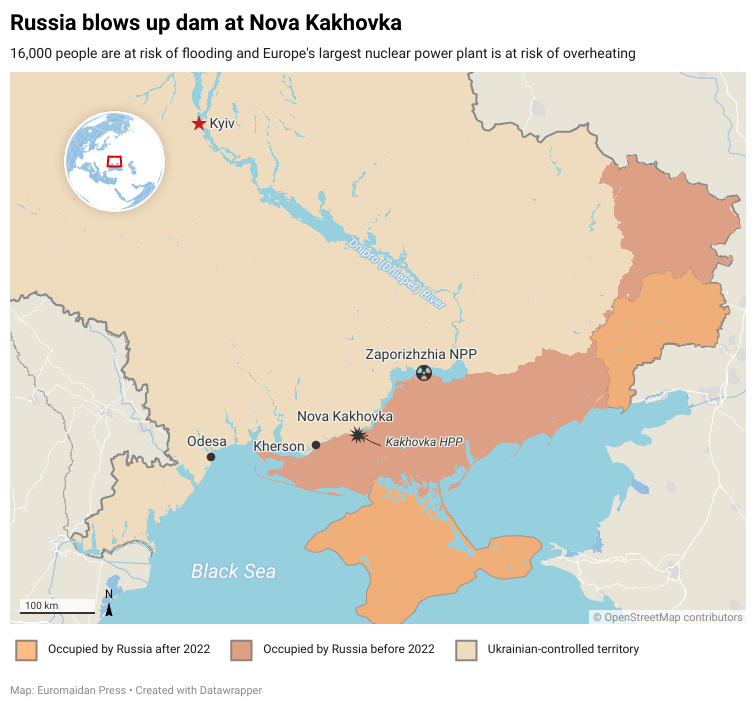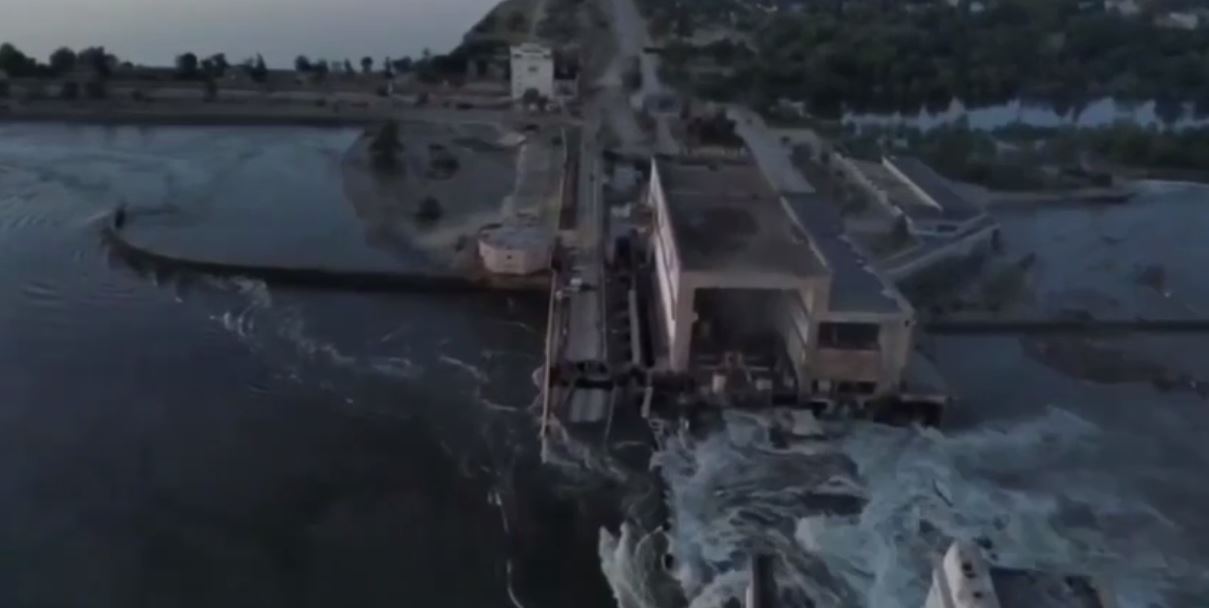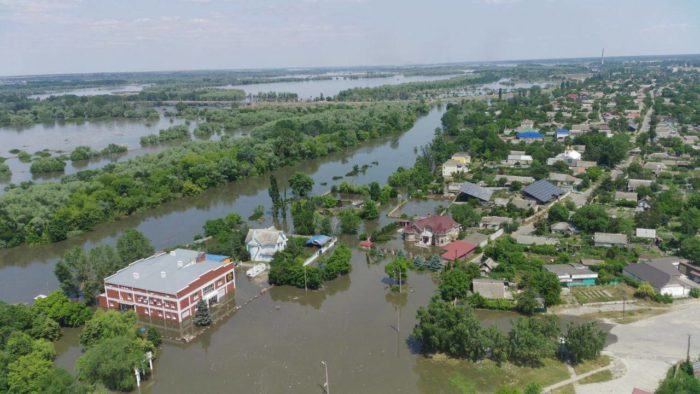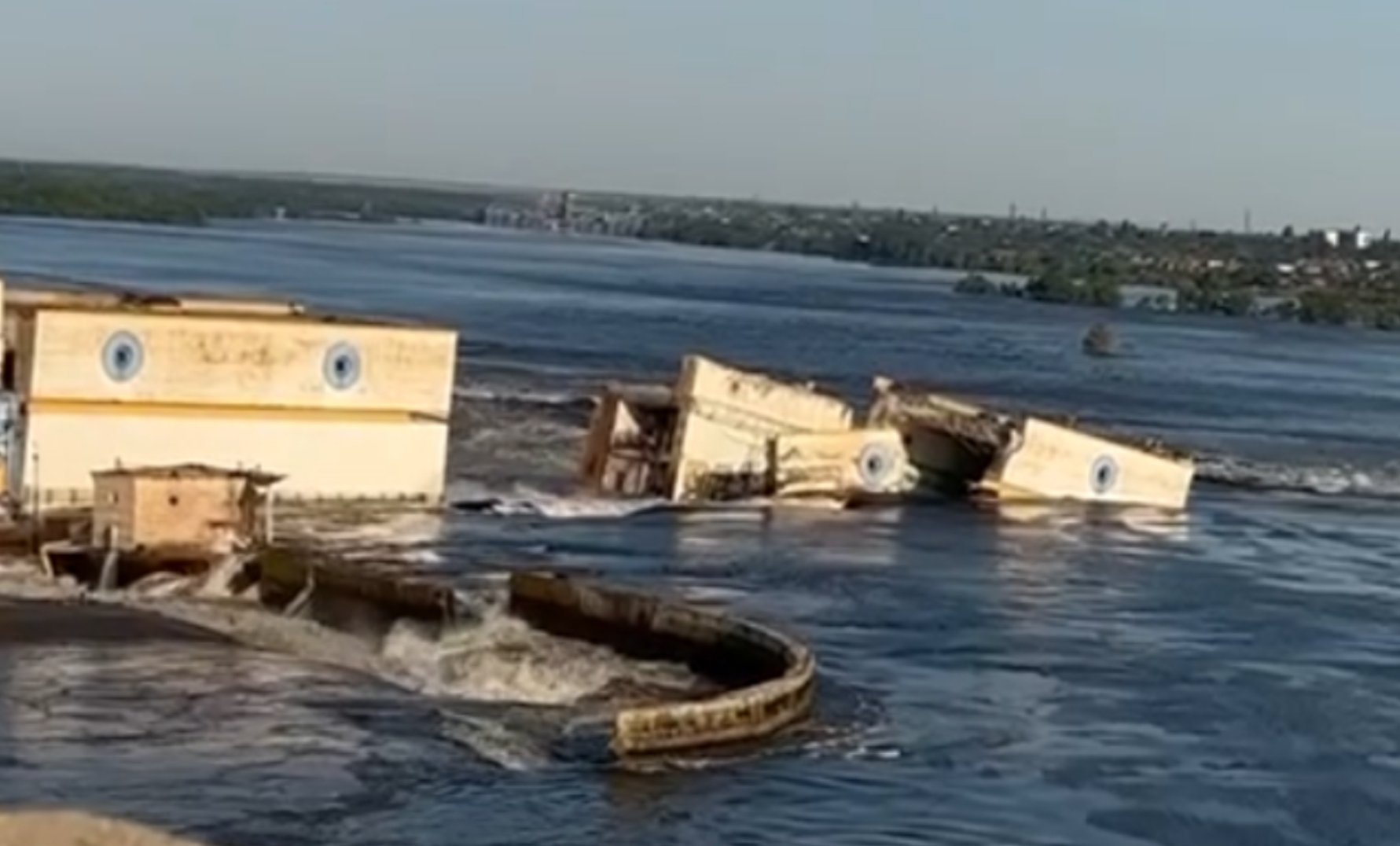Ukraine has accused Russia of blowing up the dam at Kakhovka Hydroelectric Power Station, putting 16,000 people at risk of flooding and endangering Europe’s largest nuclear power plant, the Zaporizhzhia NPP. An investigation into “ecocide” has been launched by Ukraine’s Prosecutor General.
It is an “undeniable act of ecocide and an apparent war crime, the impact of which goes far beyond Ukraine and affects the ecosystem of the entire Black Sea region,” Ukraine’s main intelligence directorate stated.
According to the Ukrainian intelligence agency, the detonation of the dam happened at 2:30 AM on 6 June. Russia carried out major mining operations immediately after seizing Kakhovka HPP back in February-March 2022. In April 2022, Russia carried out additional mining of the locks and supports and placed trucks with explosives on the dam itself, the agency wrote.
“This terrorist act is a sign of the Putin regime’s panic and an attempt to complicate the actions of the Ukrainian Security and Defense Forces. It will be a strong piece of evidence at the international tribunal that will undoubtedly be held against anyone involved in war crimes on the territory of Ukraine,” it added.
“The destruction of the Kakhovka hydroelectric power plant is the largest man-made and man-made disaster in the world in recent decades, which is killing the environment and will negatively affect the lives of hundreds of thousands of people in the coming years.
The insane goal of stopping the offensive of the [Ukraine’s] Defense Forces and avoiding defeat and shame drives the Kremlin criminals. They are ready to do anything to raise the stakes in this war.
Today’s Russia is a global threat. Only force can solve this problem,” said Andriy Yermak, head of Ukraine’s Presidential Office.
Naftohavan district in Kherson is being flooded by water from the blown-up Kakhovka dam
📽️ @suspilne_news pic.twitter.com/uheJ2xNe3p
— Euromaidan Press (@EuromaidanPress) June 6, 2023
Breaking. Russian troops have blown up the Kakhovka HPP dam.
Evacuation of locals at risk of flooding is underway and Zelenskyy is convening a NSDC meeting.
🎥 https://t.co/ryEn69RPeN pic.twitter.com/h0TjSb7KZK
— Euromaidan Press (@EuromaidanPress) June 6, 2023
Dmytro Kuleba, Ukraine’s Minister of Foreign Affairs, said that Russia’s destruction of the Kakhovka dam is “probably Europe’s largest technological disaster in decades,” which puts thousands of civilians at risk.
“This is a heinous war crime. The only way to stop Russia, the greatest terrorist of the 21st century, is to kick it out of Ukraine,” he tweeted.
Reports about the damage to the Kakhovka hydroelectric power plant began to emerge on the night of June 6 in social media. In the morning, Operational Command South confirmed that Russian troops had blown up the Kakhovka HPP. The Russian occupation authorities initially denied the destruction and later stated that the upper part of the Kakhovka HPP was destroyed allegedly as a result of shelling by Ukrainian troops, while the dam of the reservoir was not destroyed.
Head of the Kherson Oblast Administration Oleksandr Prokudin informed that the Russians blew up the dam at Nova Kakhovka in a video shared on 6:45, and stated that water levels will reach maximum levels in five hours.
The Kherson Oblast State Administration reported that units of the National Police and the State Emergency Service of the Kherson Oblast were alerted for notification and evacuation of civilians from potential flood zones on the right bank of the Dnipro River, specifically in the villages of Mykolaivka, Olhivka, Liovo, Tyhinka, Ponyativka, Ivanivka, Tokarivka, Ponyativka, Pridniprovsk, Sadove, and parts of Kherson city – Korabel Island.
As of 7:30, the Administration reported that these regions were partially or fully flooded, and indicated that 16,000 people were at risk. Kherson Oblast residents are being evacuated to Kherson, then to Mykolaiv, and from there to Khmelnytskyi, Odesa, Kropyvnytskyi, Kyiv and others.
Roman Mrochko, head of the Kherson city military administration, indicated that power supply in the Korabel neighborhood in Kherson has been cut off due to the flooding caused by the dam’s detonation. Gas supply will be turned off within a few hours for safety reasons.
Nataliia Humeniuk, the head of the United Coordination Press Center of the Defense Forces of Southern Ukraine, stated that the Russian forces had detonated the Kakhovka HPS dam in an attempt to play another card of technogenic blackmail to put pressure on Ukraine.
According to the Secretary of the National Security and Defense Council, Oleksiy Danilov, Ukrainian President Volodymyr Zelenskyy decided to hold an emergency meeting of the National Security and Defense Council of Ukraine in connection with the explosion of the Kakhovka dam.
According to Energoatom, the Russians’ detonation of the Kakhovka HPP may have negative consequences for the Zaporizhzhia Nuclear Power Plant (ZNPP), but the situation is under control.
“Water from the Kakhovka reservoir is necessary for the plant to receive feed for turbine condensers and ZNPP safety systems. The cooling pond is now full: as of 8:00 am, the water level is 16.6 meters, which is sufficient for the needs of the plant.
Energoatom is monitoring the situation and following the actions of the Russians at ZNPP together with other international organizations present at the plant, in particular, the IAEA,” the statement said.

Ukraine warned about Russia mining the dam since October 2022
On 20 October 2022, President Volodymyr Zelenskyy said in a speech to the European Council that Ukraine had information about Russians mining the dam and units at the Kakhovka HPP, and the occupiers had already “prepared everything” for this terrorist attack.
Around those days, the Institute for Study of War reported that Russia was setting information conditions to conduct a false-flag attack on the Kakhovka Hydroelectric Power Plant to cover the retreat of Russian forces from the right bank of the Dnipro River and prevent or delay Ukrainian advances across the river. Russian General Surovikin, leading the war in Ukraine, and Russian authorities in Kherson Oblast, suggested Kyiv plans to attack the local dam, causing catastrophic floods, which likely served as a pretext to accuse Ukraine of such attacks.
The ISW also supposed on 21 October that Russian troops, which were at the time retreating from the west of Kherson Oblast amid Ukraine’s offensive on the region, “will likely attempt” to blow up the dam at the Kakhovka Hydroelectric Power Plant to “cover their withdrawal and to prevent Ukrainian forces from pursuing Russian forces deeper into Kherson Oblast.”
That day, National Security and Defense Council Secretary Oleksiy Danilov said that Russia’s possible terrorist attack at the Kakhovka hydroelectric power plant would lead to numerous casualties and destroy the possibility of supplying water from the Dnipro River to Crimea for many years.
On 21 October, Natalia Humeniuk, spokeswoman Operational Command South, said that the fact that the Kakhovka HPP was mined by the Russian occupiers was known, and that the Russians were leaving the possibility of blowing it up as a “last resort.”
On 11 November, it became known that Russian forces retreating from the western-bank Kherson Oblast partially damaged the dam. CCTV footage captured a significant explosion on the dam, leading to the destruction of road and rail sections, though the dam sustained minimal damage. The full destruction of the dam could flood more than 80 settlements, including the regional capital of Kherson, Ukrainian President Volodymyr Zelenskyy said back then.
In early November 2022, the dam’s spillways were opened, causing the Kakhovka Reservoir to reach its lowest level in 30 years. This posed a risk to irrigation, drinking water resources, and the cooling systems for the Zaporizhzhia Nuclear Power Plant. Between 1 December 2022, and 6 February 2023, there was a 2-meter decrease in the water level.
What is Kakhovka dam and Kakhovka HPP
The Kakhovka Hydroelectric Power Station (HPS) was a run-of-river power plant on the Dnipro (Dnieper) River in Nova Kakhovka, a port city located on the reservoir’s southern bank. The primary purposes of the dam were hydroelectric power generation, irrigation and navigation. It was the sixth and the last dam in the Dnipro reservoir cascade. The deep water channel allowed shipping up and down river.
The dam was built in 1956 as part of the Kakhovka hydroelectric power plant, with a capacity of 357 MW. The reservoir it contained held an estimated 18 cubic kilometers of water. The dam itself was 30 meters tall and hundreds of meters wide. Water from the reservoir supplied the Crimean peninsula to the south – which was annexed by Russia in 2014 – as well as the 5.7 GW Zaporizhzhia nuclear plant – Europe’s largest – to the north.
From 2019, the facility underwent significant renovations and expansions.
The destruction of the dam adds to Ukraine’s ongoing energy problems, after Russia spent weeks earlier this year targeting vital infrastructure. It also likely wrecks the canal system that irrigates much of southern Ukraine, including Crimea.
On 24 February 2022, the power plant was captured by Russian forces during their invasion of Ukraine. During weeks of artillery attacks by Ukraine in August and September, Ukrainian and Russian officials reported that the facility’s ability to transport vehicles had been degraded, but the dam itself retained structural integrity.








